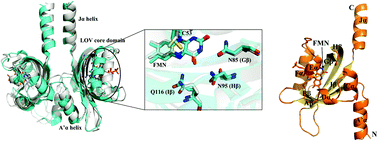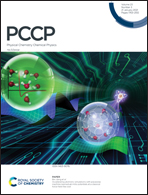A theoretical study on the signal transduction process of bacterial photoreceptor PpSB1 based on the Markov state model†
Abstract
Light–oxygen–voltage (LOV) domains are blue light sensors and play an important role in signal transduction in many organisms. Generally, LOV domains use chromophores to absorb photons, and then photochemical reactions will occur to convert light energy into chemical energy and transduce it to the main chain of proteins. These reactions can cause conformational rearrangement of proteins, and thus leading to signal transduction. Therefore, it is important to study the signal transduction process of LOV domains for understanding the control mechanism of cellular functions. However, how small photochemical changes in the active sites of the LOV domains lead to large conformational rearrangements of proteins, which in turn lead to signal transduction, has been puzzling us for a long time. Currently, the LOV domains are mainly studied in plants. The signal transduction mechanism of LOV domains in bacteria is still unclear. In this work, the Markov state model (MSM) combined with molecular dynamics (MD) simulations was applied to investigate the signal transduction process of the LOV protein from pseudomonas putida (PpSB1-LOV). The present work will play an important role in understanding the signal transduction mechanism of PpSB1-LOV domains, which may provide theoretical basis for the design and improvement of LOV-based optogenetic tools.



 Please wait while we load your content...
Please wait while we load your content...